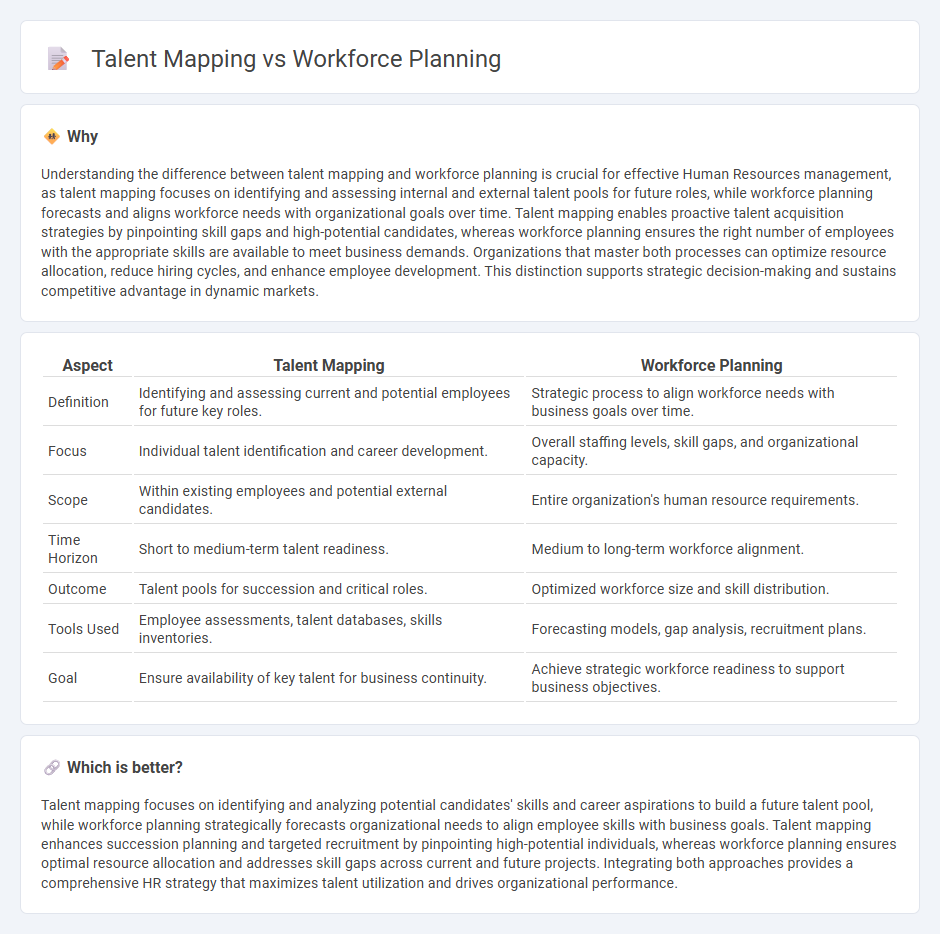
Talent mapping identifies current and potential skills within an organization to align employee capabilities with strategic goals. Workforce planning forecasts future staffing needs based on business objectives and market trends, ensuring the right number of employees with the right skills. Explore how integrating talent mapping and workforce planning drives organizational success.
Why it is important
Understanding the difference between talent mapping and workforce planning is crucial for effective Human Resources management, as talent mapping focuses on identifying and assessing internal and external talent pools for future roles, while workforce planning forecasts and aligns workforce needs with organizational goals over time. Talent mapping enables proactive talent acquisition strategies by pinpointing skill gaps and high-potential candidates, whereas workforce planning ensures the right number of employees with the appropriate skills are available to meet business demands. Organizations that master both processes can optimize resource allocation, reduce hiring cycles, and enhance employee development. This distinction supports strategic decision-making and sustains competitive advantage in dynamic markets.
Comparison Table
| Aspect | Talent Mapping | Workforce Planning |
|---|---|---|
| Definition | Identifying and assessing current and potential employees for future key roles. | Strategic process to align workforce needs with business goals over time. |
| Focus | Individual talent identification and career development. | Overall staffing levels, skill gaps, and organizational capacity. |
| Scope | Within existing employees and potential external candidates. | Entire organization's human resource requirements. |
| Time Horizon | Short to medium-term talent readiness. | Medium to long-term workforce alignment. |
| Outcome | Talent pools for succession and critical roles. | Optimized workforce size and skill distribution. |
| Tools Used | Employee assessments, talent databases, skills inventories. | Forecasting models, gap analysis, recruitment plans. |
| Goal | Ensure availability of key talent for business continuity. | Achieve strategic workforce readiness to support business objectives. |
Which is better?
Talent mapping focuses on identifying and analyzing potential candidates' skills and career aspirations to build a future talent pool, while workforce planning strategically forecasts organizational needs to align employee skills with business goals. Talent mapping enhances succession planning and targeted recruitment by pinpointing high-potential individuals, whereas workforce planning ensures optimal resource allocation and addresses skill gaps across current and future projects. Integrating both approaches provides a comprehensive HR strategy that maximizes talent utilization and drives organizational performance.
Connection
Talent mapping identifies key skills and competencies within the workforce, providing a detailed profile of existing and potential talent. Workforce planning uses this data to forecast future staffing needs, align recruitment strategies, and address skill gaps. Integrating talent mapping with workforce planning ensures organizations optimize human capital for sustained business growth and agility.
Key Terms
**Workforce Planning:**
Workforce planning involves forecasting an organization's future human resource needs by analyzing current staff capabilities, anticipated retirements, and business growth projections to ensure optimal staffing levels. This strategic process integrates labor market trends, skill gap assessments, and succession planning to maintain organizational agility and competitiveness. Explore more insights on how effective workforce planning drives sustainable business growth and resilience.
Succession Planning
Workforce planning strategically aligns organizational goals with future staffing needs by analyzing current employee capabilities and forecasting demand for skills, while talent mapping visually assesses internal and external talent pools to identify high-potential candidates for critical roles. Both processes underpin effective succession planning by ensuring continuity through proactive identification and development of successors, reducing leadership gaps and promoting organizational resilience. Discover how integrating workforce planning and talent mapping can enhance your succession planning strategy.
Demand Forecasting
Workforce planning centers on demand forecasting by analyzing future organizational needs based on business goals, market trends, and economic factors to ensure the right number of employees with appropriate skills. Talent mapping focuses on identifying and tracking existing talent pools and potential candidates to fill anticipated roles efficiently. Discover how strategic demand forecasting enhances both workforce planning and talent mapping effectiveness.
Source and External Links
What Is Workforce Planning? Strategies and Benefits - This article provides an overview of workforce planning, including assessing current workforce, forecasting future needs, identifying gaps, developing action plans, and continuous monitoring and evaluation.
Workforce Planning: Definition, Process and Principles - This resource explains the definition and process of workforce planning, including determining strategic direction, conducting supply and demand analysis, and aligning talent with business objectives.
Workforce Planning - This governmental resource outlines the workforce planning process as analyzing and forecasting workforce supply and demand, assessing gaps, and implementing talent management interventions to achieve strategic objectives.
 dowidth.com
dowidth.com